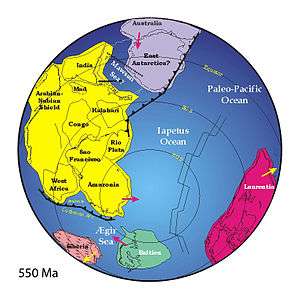Wilson Cycle
The Wilson cycle is a model where a continental rift breaks up a continent, leading to the formation of an ocean basin between two lithospheric plates. The separation of the two plates is followed later by convergence that leads to the closure of the ocean basin, and eventually to the collision of the two continental blocks.


It has been suggested that Wilson cycles on Earth started about 3 Ga (3 billion years) ago in the Proterozoic Eon of Earth's history.[1]
History
The model is named after its originator John Tuzo Wilson.[2] The term "Wilson cycle" was introduced in 1974 by Kevin C. A. Burke, who was a colleague and friend of Wilson.[3]
Distinct from supercontinent formation process
A Wilson cycle is not the same as a supercontinent cycle, which is the break-up of one supercontinent and the development of another and takes place on a global scale.
The Wilson cycle rarely synchronizes with the timing of a supercontinent cycle.[4] However, both supercontinent cycles and Wilson cycles were involved in the formation of Pangaea and of Rodinia.[5]
References
- Shirey, Steven B.; Richardson, Stephen H. (2011). "Start of the Wilson cycle at 3 Ga shown by diamonds from subcontinental mantle". Science. 333 (6041): 434–436. Bibcode:2011Sci...333..434S. doi:10.1126/science.1206275. PMID 21778395.
- Wilson, J. Tuzo (1 August 1966). "Did the Atlantic close and then re-Open?". Nature. 211 (5050): 676–681. Bibcode:1966Natur.211..676W. doi:10.1038/211676a0. ISSN 1476-4687.
- Dewey, John F.; Burke, Kevin (1 February 1974). "Hot spots and continental break-up: Implications for collisional orogeny". Geology. 2 (2): 57–60. doi:10.1130/0091-7613(1974)2<57:hsacbi>2.0.co;2. ISSN 0091-7613.
- John J.W., Rogers; Santosh, M. (2004). Continents and Supercontinents. Oxford, UK: Oxford University Press.
- Fluteau, Frédéric (2003). "Earth dynamics and climate changes". C. R. Geoscience. 335 (1): 157–174. doi:10.1016/S1631-0713(03)00004-X.